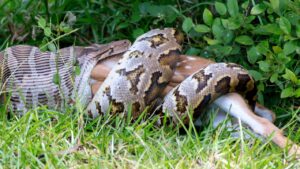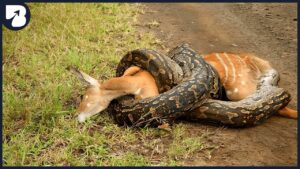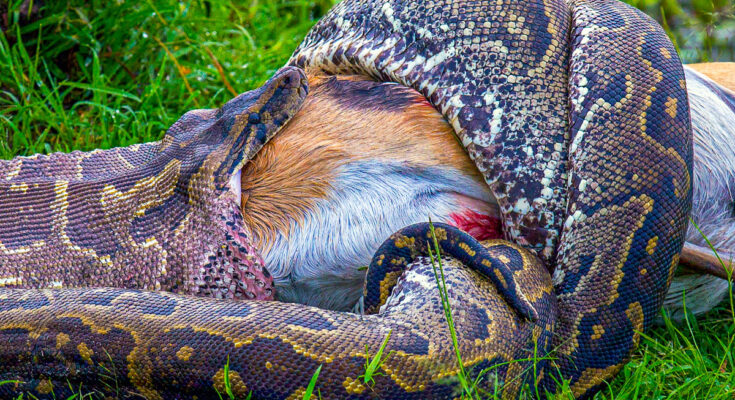In the diverse and often perilous landscapes of the wild, the struggle for survival is an ongoing drama that plays out between predators and their prey. Among the most formidable predators are the large constrictor snakes, such as the python. These reptiles possess a combination of stealth, strength, and patience that make them master hunters. The scenario of a huge python squeezing and fully consuming a gazelle is a stark illustration of the raw power and primal instincts that govern the natural world. This essay explores the predatory behavior of pythons, the physiology behind their constriction and consumption methods, and the ecological implications of their hunting strategies.
Pythons are non-venomous constrictor snakes found in Africa, Asia, and Australia. Among the largest of their kind, species such as the African rock python (Python sebae) and the reticulated python (Python reticulatus) are capable of taking down large prey, including antelopes and gazelles. These snakes rely on camouflage and stealth to approach their prey. Their patterned skin blends seamlessly with the surrounding foliage, allowing them to lie in wait for unsuspecting animals to come within striking distance.

The act of constriction is both a testament to the python’s physical power and an efficient means of subduing prey. When a python strikes, it uses its sharp, backward-facing teeth to secure a hold on the prey. It then rapidly coils its muscular body around the animal. The strength of a python’s squeeze is immense; with each breath the prey exhales, the python tightens its coils, preventing the animal from inhaling again. This leads to suffocation, or in some cases, circulatory arrest due to the immense pressure on the heart and blood vessels.
Constriction is a precise and lethal method that ensures the prey is subdued quickly and efficiently, minimizing the risk of injury to the snake. This method of predation reflects the evolutionary adaptations of pythons to their environment, allowing them to hunt and consume prey much larger than themselves.

Once the gazelle is subdued, the python begins the process of consumption. Pythons have highly flexible jaws connected by stretchy ligaments, allowing them to open their mouths wide enough to engulf large animals. The snake’s digestive system is equally adapted to handle such feats. Powerful digestive enzymes break down the prey, bones and all, over a period of days to weeks.
The process begins with the python positioning the head of the gazelle in its mouth. Using rhythmic movements known as “walk feeding,” where the snake moves its jaws over the prey in a motion reminiscent of walking, the python gradually works the entire body of the gazelle into its digestive tract. During this time, the python is particularly vulnerable, as its capacity to move quickly is significantly reduced by the size of its meal.
The predatory behavior of pythons plays a critical role in maintaining the balance of their ecosystems. By preying on herbivores like gazelles, pythons help regulate the population sizes of these animals, which in turn influences the vegetation dynamics and overall health of the habitat. This natural control mechanism underscores the importance of apex predators in ecosystem stability and biodiversity.
However, the presence of large pythons can also lead to conflicts with humans, particularly in areas where human encroachment on natural habitats brings people and large snakes into closer proximity. Understanding the behavior and ecological role of pythons can aid in the development of conservation strategies that protect both these remarkable reptiles and the human communities that share their habitats.
The image of a huge python squeezing and fully consuming a gazelle encapsulates the raw, unfiltered power of nature. Pythons, with their extraordinary physical adaptations and predatory strategies, are a testament to the evolutionary processes that shape life on Earth. Their role as apex predators is crucial for the health and balance of their ecosystems, highlighting the intricate web of interactions that sustain biodiversity. By appreciating and understanding these dynamics, we can foster a deeper respect for the natural world and the remarkable creatures that inhabit it.



